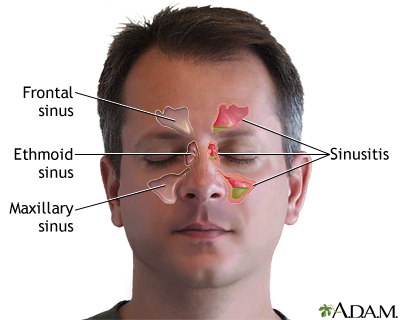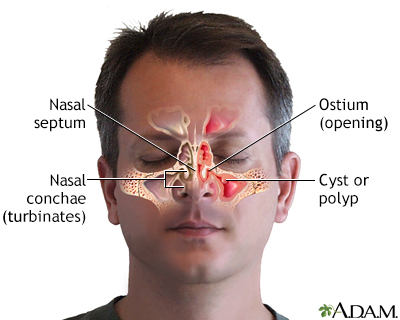| Sinusitis |
"Sinusitis" refers to inflammation of the nasal sinus cavities, which are moist, hollow spaces in the bones of the skull. There are four pairs of sinuses: frontal, maxillary, ethmoid, and sphenoid. The sinuses are located behind the eyebrows, cheekbones, and nose. The sinuses help moisten and warm air that is filtered by the nose, serving to protect the lungs. The sinuses also play a role in voice resonation.
 |
The sinus cavities, nose, and lungs are lined with mucous membranes, which protect the airways by trapping irritants that are inhaled. Tiny hair-like filaments called cilia are in constant movement and sweep mucus and the trapped irritants out of the airways and nasal passages. In the sinuses, the mucus drains out of a tiny opening called the ostium.
The ostium of any sinus cavity can get plugged. When this blockage prevents the flow of mucus, the pressure builds up, leading to sinusitis (inflammation and pain). If the blocked sinus becomes infected with bacteria, the sinus becomes even more inflamed and painful.

| There are four different pairs of sinuses -- the frontal, ethmoid, maxillary, and sphenoid sinuses. In this illustration, the sinuses on the right side are shown as inflamed and infected, although any sinus can be affected. The sphenoid sinuses are not shown because they are further back in the head. |
Symptoms
Sinusitis often affects people who have a stuffy or runny nose due to allergies (allergic rhinitis). Nasal discharge may be either a symptom or a cause of sinusitis. Other symptoms of sinusitis can include:
- Facial pain or pressure
- Thick, discolored mucus (yellow or green)
- Diminished sense of smell
- Cough (worse when laying down)
- Headache
- Bad breath
- Fever
- Toothache
- Pressure in the ears
- Fatigue
Acute vs. chronic sinusitis
Sinusitis can be acute or chronic. Acute sinusitis usually lasts for 3 weeks but can persist for as long as 3 months. Acute sinusitis is often accompanied by high fever in young children.
Chronic sinusitis lasts longer than 3 months and does not respond to conventional antibiotic treatment. Symptoms of chronic sinusitis are less severe than those of acute, but can last for years.
A distinguishing symptom of chronic sinusitis is a persistent cough -- with sinusitis in children, cough may be the only symptom.
Causes
Acute sinusitis is usually caused by a viral respiratory infection. Chronic sinusitis can also be caused by infection, but is more often caused by inflammation and blockage due to allergies or a physical obstruction (deviated septum, misformed bone or cartilage structures, nasal polyps, tumors, or foreign objects).

| This view shows the bones and cartilage that surround the sinuses, including the septum and the turbinates. The septum and turbinates can block the sinuses, leading to pain and inflammation. |
The septum separates the two sides of the nasal cavity. A "deviated septum" is one that is crooked or misformed; in some cases a deviated septum may actually block the opening to one of the sinuses.
The turbinates are bones that usually help protect the openings to the sinuses. The ostium is a tiny canal between the turbinates that drains a sinus cavity. Any structural problem in the turbinates (by birth or from an accident) can block the canal.
A cyst or polyp is a harmless structure that, depending on how big it gets and where it is located in the sinus, can block the ostium.
Some people have structural problems that partially block the sinuses, and their allergies just make the problem even worse.
Other factors that may contribute or cause sinusitis (both acute and chronic) include a weakened immune system due to existing illness, cocaine abuse, overuse of decongestant nasal sprays, and activities like swimming and diving.
Diagnosing sinusitis
If you suspect you have sinusitis, ask your primary care physician for a referral to an Ear, Nose, and Throat (ENT) doctor (also called an otorhinolaryngologist). If you have bad allergies and think they may be causing sinusitis, ask for a referral to an allergist.
To make a diagnosis, your doctor will need to consider all of your symptoms. Your doctor will examine your nasal and sinus passages with an endoscope to see whether your sinuses are clear or inflamed with excess, cloudy mucus.

A computerized tomography (CT) scan of the sinuses (shown above) can be considered the "gold standard" in diagnosing sinusitis. The CT scan allows the doctor to clearly see where there are healthy pockets of air versus mucus build-up, structural obstruction, and inflammation in your sinuses.
Often, your doctor may feel that you clinically have sinutsitis and will treat you based on the symptoms without performing a CT scan.
Treatment and management
Acute sinusitis may require aggressive treatment with antibiotics. If you don't respond to the medication within 3 - 5 days, your doctor may change your prescription for a stronger antibiotic. Chronic sinusitis may require as many as 6 weeks of treatment with antibiotics.
Decongestant medications may relieve symptoms of stuffy, runny nose that accompany sinusitis. Corticosteroid nasal sprays may help with inflammation.
If you don't respond to antibiotics and continue to experience symptoms, surgery may be recommended. If you have nasal polyps, a deviated septum, or other obstructive growths, surgery may be the only answer to relieve your symptoms.
Nasal irrigation with saline is often recommended for people with sinusitis, particularly those having undergone surgery. It helps to clean out the sinuses and nasal passageways after surgery.
If you suspect that you have allergies, determine what you may be allergic to with allergy testing, so you can avoid them. If you can control your allergies, you may find that your sinusitis symptoms clear up too.
References
Rosenfeld RM, Andres D, Bhattacharyya N, Cheung D, Eisenberg S, Ganiats TG, et al. Clinical practice guideline: adult sinusitis. Otolaryngol Head Neck Surg. Sep 2007;137(3 suppl):S1-31.
Reviewed By: Allen J. Blaivas, DO, Clinical Assistant Professor of Medicine UMDNJ-NJMS, Attending Physician in the Division of Pulmonary, Critical Care, and Sleep Medicine, Department of Veteran Affairs, VA New Jersey Health Care System, East Orange, NJ. Review provided by VeriMed Healthcare Network. Previoulsy reviewed by David A. Kaufman, MD, Section Chief, Pulmonary, Critical Care & Sleep Medicine, Bridgeport Hospital-Yale New Haven Health System, and Assistant Clinical Professor, Yale University School of Medicine, New Haven, CT. Review provided by VeriMed Healthcare Network. (6/1/2010)
